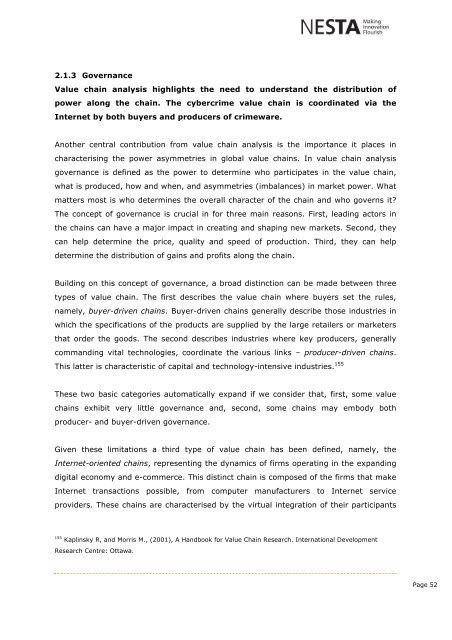NESTA Crime Online - University of Brighton Repository
NESTA Crime Online - University of Brighton Repository
NESTA Crime Online - University of Brighton Repository
Create successful ePaper yourself
Turn your PDF publications into a flip-book with our unique Google optimized e-Paper software.
2.1.3 Governance<br />
Value chain analysis highlights the need to understand the distribution <strong>of</strong><br />
power along the chain. The cybercrime value chain is coordinated via the<br />
Internet by both buyers and producers <strong>of</strong> crimeware.<br />
Another central contribution from value chain analysis is the importance it places in<br />
characterising the power asymmetries in global value chains. In value chain analysis<br />
governance is defined as the power to determine who participates in the value chain,<br />
what is produced, how and when, and asymmetries (imbalances) in market power. What<br />
matters most is who determines the overall character <strong>of</strong> the chain and who governs it?<br />
The concept <strong>of</strong> governance is crucial in for three main reasons. First, leading actors in<br />
the chains can have a major impact in creating and shaping new markets. Second, they<br />
can help determine the price, quality and speed <strong>of</strong> production. Third, they can help<br />
determine the distribution <strong>of</strong> gains and pr<strong>of</strong>its along the chain.<br />
Building on this concept <strong>of</strong> governance, a broad distinction can be made between three<br />
types <strong>of</strong> value chain. The first describes the value chain where buyers set the rules,<br />
namely, buyer-driven chains. Buyer-driven chains generally describe those industries in<br />
which the specifications <strong>of</strong> the products are supplied by the large retailers or marketers<br />
that order the goods. The second describes industries where key producers, generally<br />
commanding vital technologies, coordinate the various links – producer-driven chains.<br />
This latter is characteristic <strong>of</strong> capital and technology-intensive industries. 155<br />
These two basic categories automatically expand if we consider that, first, some value<br />
chains exhibit very little governance and, second, some chains may embody both<br />
producer- and buyer-driven governance.<br />
Given these limitations a third type <strong>of</strong> value chain has been defined, namely, the<br />
Internet-oriented chains, representing the dynamics <strong>of</strong> firms operating in the expanding<br />
digital economy and e-commerce. This distinct chain is composed <strong>of</strong> the firms that make<br />
Internet transactions possible, from computer manufacturers to Internet service<br />
providers. These chains are characterised by the virtual integration <strong>of</strong> their participants<br />
155 Kaplinsky R, and Morris M., (2001), A Handbook for Value Chain Research. International Development<br />
Research Centre: Ottawa.<br />
Page 52
















